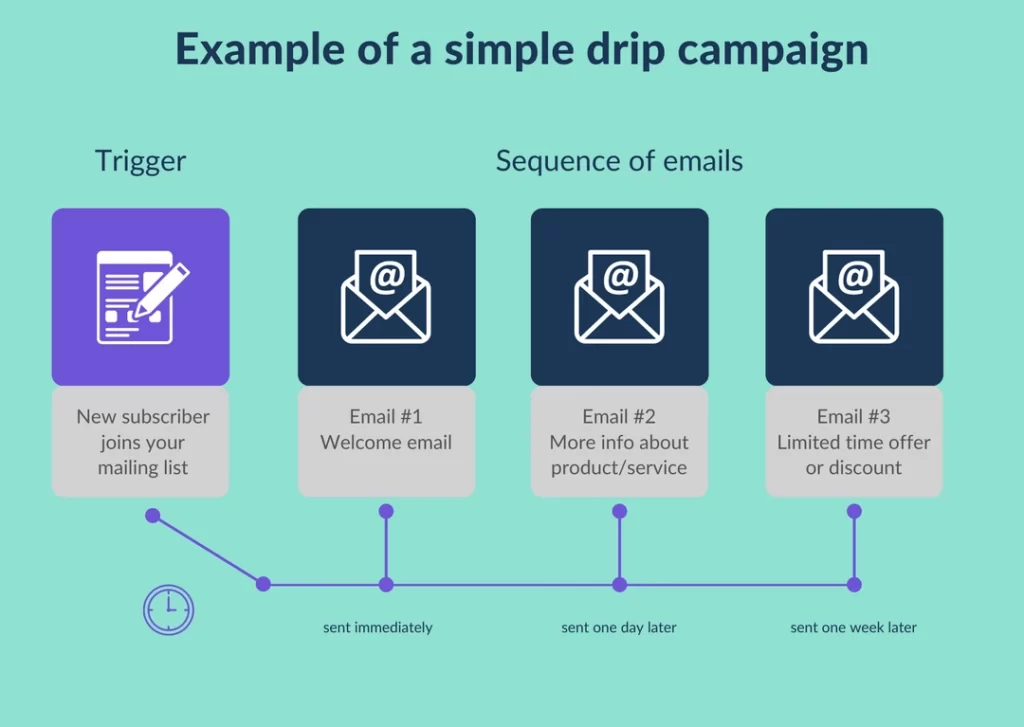Drip Marketing: How to Nurture and Convert Leads
In a rapidly evolving digital landscape, a one-and-done approach to marketing is as outdated as dial-up internet. Welcome to the era of drip marketing—a sophisticated, customer-centric strategy that's driving impressive results. According to a recent report by Annuitas, nurtured leads make staggering 47% larger purchases than non-nurtured leads. Yet, surprisingly, as much as 65% of companies haven't established lead nurturing strategies, leaving a significant amount of potential business growth untapped.
“Drip Marketing: How to Nurture and Convert Leads” will delve into the depths of this transformative marketing methodology. We'll explore how drip marketing, like the slow and steady drip of water that nourishes a plant to full bloom, is about gradually building relationships with potential customers—nurturing leads until they're ripe for conversion. Get ready to discover the art and science of drip marketing, a strategy proving its value in numbers and revolutionising customer engagement in today's hyper-connected world.
Table of Contents
What is Drip Marketing?

Drip marketing is an automated marketing strategy that sends targeted and personalised messages to prospects and customers over a predetermined period. Unlike traditional one-time email blasts, drip campaigns are designed to deliver relevant content and offers based on the recipient's behaviour, preferences, or position in the sales funnel. By providing timely and tailored messages, drip marketing aims to nurture leads, build relationships, and guide prospects towards conversion.
Critical Components of Drip Marketing
- Automation Tools: Drip marketing relies on sophisticated marketing automation software to send messages automatically based on predefined triggers and rules. These tools allow marketers to design, schedule, and track the performance of their drip campaigns efficiently.
- Segmentation: Successful drip campaigns leverage audience segmentation to ensure that each message resonates with the specific needs and interests of the recipients. Segmentation can be based on demographics, past interactions, purchase history, or other relevant criteria.
- Content: Compelling content is the backbone of any successful drip marketing campaign. Each message should provide value, address pain points, and align with the recipient's stage in the buyer's journey. It can include blog posts, e-books, case studies, videos, webinars, or exclusive offers.
- Timing and Frequency: Drip campaigns require careful planning of the timing and frequency of messages. Too many messages can overwhelm recipients, leading to unsubscribes or disengagement, while too few messages may fail to keep prospects engaged. Finding the right balance is crucial for optimal results.
- Testing and Optimisation: Continuous testing and optimisation play a pivotal role in the success of drip marketing campaigns. Marketers should analyse key metrics like open rates, click-through rates, and conversions to identify areas for improvement and refine their strategies accordingly.
Benefits of Drip Marketing

Nurturing Leads
Drip marketing is a powerful tool for nurturing leads throughout the buyer's journey. Drip campaigns keep prospects engaged and build trust by delivering relevant and timely content. This consistent engagement helps educate prospects about your products or services, addresses their pain points, and positions your brand as a valuable resource.
According to a study by Marketo, companies that excel at lead nurturing generate 50% more sales-ready leads at a 33% lower cost. Drip marketing allows you to guide prospects through the sales funnel, gradually moving them closer to conversion and increasing the likelihood of a successful sale.
Increasing Conversion Rates
One of the primary goals of drip marketing is to convert leads into customers. Drip campaigns can significantly impact conversion rates by delivering personalised and targeted messages. According to Campaign Monitor, personalised emails have 29% higher open rates and 41% higher click-through rates than generic emails. Drip marketing allows you to tailor your messages based on the recipient's interests, preferences, and behaviours, increasing the chances of conversion.
- Treacey, Matt (Author)
- English (Publication Language)
- 196 Pages – 09/22/2022 (Publication Date) – Symbios Growth Automation (Publisher)
Enhancing Customer Retention
Drip marketing is not limited to acquiring new customers; it is also an effective strategy for enhancing customer retention. Drip campaigns can strengthen the relationship between your brand and customers by continuously sending relevant and valuable content to existing customers. This regular engagement keeps your brand top of mind and encourages customer loyalty.
According to research by Bain & Company, increasing customer retention rates by just 5% can lead to a 25% to 95% increase in profits. Drip marketing lets you stay connected with your customers, providing them valuable information, exclusive offers, and personalised recommendations. You can improve customer satisfaction, reduce churn, and drive repeat purchases by nurturing existing customers.
Saving Time and Resources
Another significant benefit of drip marketing is its automation capabilities, saving marketers valuable time and resources. Once you've set up a drip campaign, it will continue to run automatically, delivering messages to your audience without requiring manual intervention for each send.
By automating your marketing processes, you can focus on other essential aspects of your business, such as strategy development, content creation, and analysing campaign performance. Additionally, automation helps ensure consistency and accuracy in delivering messages, reducing the risk of human error.
Gaining Valuable Insights
Drip marketing campaigns give marketers valuable insights into their audience's behaviour, preferences, and engagement patterns. You can measure your campaigns' effectiveness and identify improvement areas by tracking key metrics such as open, click-through, and conversion rates.
Furthermore, through A/B testing, you can experiment with different messaging, subject lines, and offers to optimise your campaigns for better results. The data and insights gained from drip marketing campaigns can inform your overall marketing strategy, allowing you to make data-driven decisions and refine your tactics for maximum impact.
Implementing a Successful Drip Marketing Campaign
Step 1: Define Your Goals and Target Audience
Before creating a drip marketing campaign, defining your goals and identifying your target audience is essential. What specific outcomes do you want to achieve through your campaign? Are you aiming to generate leads, nurture prospects, increase conversions, or retain customers? Defining your goals will help you shape your campaign strategy and determine the appropriate messaging and content.
Next, identify your target audience. Who are the individuals you want to reach with your campaign? Consider demographics, interests, behaviours, and stages in the buyer's journey. The more specific and detailed your audience segmentation, the more personalised and effective your drip campaigns will be.
Step 2: Select the Right Automation Tool
Choosing the right marketing automation tool is crucial for the success of your drip marketing campaigns. Several excellent options are available in the market, each with strengths and features. Look for a tool that offers intuitive campaign design and management, robust segmentation capabilities, easy integration with your existing systems, and comprehensive analytics and reporting.
Popular marketing automation tools like HubSpot, Marketo, and Mailchimp provide robust drip campaign functionality and can streamline your automation processes effectively. Consider your budget, specific requirements, and scalability when selecting the tool that best fits your needs.
Step 3: Create Engaging and Relevant Content
Compelling content lies at the heart of successful drip marketing campaigns. Each message in your drip campaign should provide value to your audience and resonate with their needs and interests. Consider the different stages of the buyer's journey and tailor your content accordingly.
For example, in the awareness stage, focus on educational content that addresses common pain points and introduces your brand as a solution. In the consideration stage, provide more in-depth content, such as case studies, product demos, or comparison guides, to help prospects evaluate their options. In the decision stage, offer persuasive content, testimonials, and limited-time offers to encourage conversion.
Remember to maintain consistency in your brand voice and messaging throughout the campaign to strengthen brand recognition and trust.
- Bacak, Matt (Author)
- English (Publication Language)
- 72 Pages – 10/05/2021 (Publication Date) – Catapult Press (Publisher)
Step 4: Design a Well-Structured Campaign
When designing your drip marketing campaign, it's crucial to structure it in a way that guides leads through the buyer's journey and maximises engagement. Here are some key elements to consider:
- Campaign Flow: Plan the sequence and timing of your drip campaign messages. Determine how many messages you want to include and the intervals between each message. Align the timing with your audience's preferences and behaviours. For example, if you notice that your audience is more active on weekdays, schedule your messages accordingly.
- Subject Lines: Craft compelling subject lines that grab attention and entice recipients to open your emails. A/B testing different subject lines can help you identify which ones generate higher open rates.
- Personalisation: Leverage the data you have about your audience to personalise your messages. Use merge tags to insert the recipient's name or other relevant details into the email content. Personalisation can significantly increase engagement and make recipients feel valued.
- Call to Action: Each message in your drip campaign should have a clear and compelling call to action (CTA). Whether directing recipients to a landing page, inviting them to register for a webinar, or encouraging them to purchase, the CTA should be prominently displayed and persuasive.
- Testing and Optimisation: Continuously monitor the performance of your drip campaign and make data-driven optimisations. Test elements such as email copy, CTAs, visuals, and send times to identify what resonates best with your audience. Use the insights gained to refine and improve your campaign over time.
- Avoiding Spam Filters: Follow email deliverability best practices to ensure that your drip campaign messages reach the intended recipient's inboxes. Avoid using spam-triggering words or phrases in your subject lines and email content. Regularly clean your email list to remove inactive or invalid email addresses.
Step 5: Measure and Analyse Results
To gauge the success of your drip marketing campaign, it's essential to track and measure key metrics. Here are some metrics to focus on:
- Open Rate: The percentage of recipients who opened your emails. A high open rate indicates that your subject lines and sender name effectively capture attention.
- Click-Through Rate (CTR): The percentage of recipients who clicked on links within your emails. A higher CTR indicates that your content and CTAs are engaging and compelling.
- Conversion Rate: The percentage of recipients who completed a desired action, such as purchasing, filling out a form, or downloading content. A higher conversion rate indicates that your campaign is effectively driving desired actions.
- Unsubscribe Rate: The percentage of recipients who unsubscribe from your drip campaign. Monitoring your unsubscribe rate can help you assess whether your content or frequency needs adjustment.
- ROI: Calculate your drip marketing campaign's return on investment (ROI) by analysing the revenue generated from conversions compared to the campaign's cost. This metric provides insights into the campaign's effectiveness and helps justify its value.
By analysing these metrics, you can identify areas of improvement, optimise your campaign, and make informed decisions for future iterations.
Best Practices for Drip Marketing

To make the most of your drip marketing campaigns, consider these best practices:
- Segmentation and Personalisation: Invest time segmenting your audience and personalising your messages. The more relevant and targeted your content, the higher the engagement and conversion rates will be.
- Consistency: Maintain a consistent brand voice and messaging throughout your drip campaign. This consistency builds trust and reinforces your brand identity.
- Value-Driven Content: Provide valuable and informative content that addresses your audience's pain points and offers solutions. Focus on educating and helping your prospects rather than solely promoting your products or services.
- Automation and Timeliness: Leverage the power of automation to deliver timely messages. Set up triggers and actions that automatically send messages based on user behaviour or predefined time intervals. This ensures that your drip campaign stays relevant and timely.
- Test and Optimise: Continuously test different elements of your drip campaign, including subject lines, email content, CTAs, and send times. Use A/B testing to compare performance and optimise for better results. Minor tweaks can make a significant impact on engagement and conversion rates.
- Maintain a Clean Email List: Regularly clean your email list to remove inactive or invalid email addresses. This helps improve deliverability and ensures that your messages reach the intended recipients.
- Monitor and Analyse: Keep a close eye on the performance metrics of your drip campaign. Analyse the data to gain insights into what is working and needs improvement. Use the data to make data-driven decisions and refine your campaign strategy.
- Iterate and Improve: Drip marketing is an ongoing process. Continuously iterate and improve your campaigns based on the insights and feedback you receive. Stay updated with the latest industry trends and adjust your strategies accordingly.
- Integrate with Other Marketing Channels: Drip marketing should not exist in isolation. Integrate your drip campaigns with other marketing channels, such as social media, content marketing, and paid advertising. This creates a cohesive and comprehensive marketing strategy that maximises your reach and engagement.
- Compliance with Data Privacy Regulations: Ensure that your drip marketing campaigns comply with data privacy regulations, such as GDPR or CCPA. Obtain proper consent from your subscribers and provide options for opting out or unsubscribing.
By following these best practices, you can create highly effective drip marketing campaigns that nurture leads, drive conversions, and enhance customer relationships.
- White, Chad S. (Author)
- English (Publication Language)
- 402 Pages – 03/05/2023 (Publication Date) – Independently published (Publisher)
Conclusion
And there you have it, folks! We've journeyed through the ins and outs, the nuts and bolts, the nitty-gritty of drip marketing. We've seen how it's not just about bombarding leads with information but cultivating relationships and building trust over time. By providing relevant content at the right time, we're speaking directly to our leads' needs and interests, making them feel valued and understood.
Customers are constantly bombarded with marketing messages in the fast-paced digital world. The businesses that take the time to understand, engage, and nurture their leads truly stand out from the crowd. Drip marketing allows us to do just that, turning an initial spark of interest into a steady flame of customer loyalty.
And let's remember those figures we started with. A whopping 47% increase in purchase size from nurtured leads. That's a statistic any marketer would drool over! But remember, it's not just about the numbers. Drip marketing also allows us to build genuine relationships with our customers, which in the end, is the most rewarding outcome of all.
So whether you're a small business owner looking to grow or a seasoned marketing professional seeking to maximise your results, drip marketing is a potent tool in your arsenal. It's a long game, but as we've seen, the payoff is more than worth the effort.
And that, my fellow marketers, is the power of drip marketing. It's more than just a strategy—a philosophy, a mindset, a way of doing business. It's about nurturing leads and converting them into customers and brand advocates. Happy dripping!
Last update on 2024-05-31 / Affiliate links / Images from Amazon Product Advertising API



